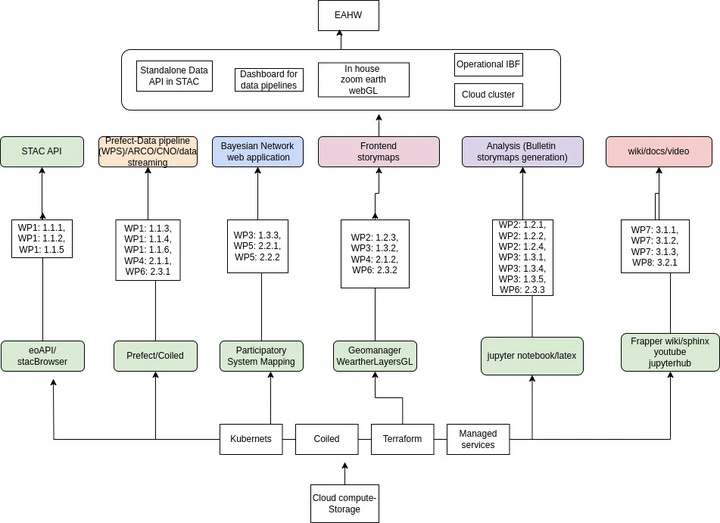The tech stack for e4drr project

Planned E4DRR Technical Architecture: Six Core Components Under Development
The project “Hazard Modeling, Impact Estimation, Climate Storylines for Drought and Flood Disasters in Eastern Africa (E4DRR)” is designed to enhance the East Africa Hazard Watch (EAHW) platform as a decision-support and anticipatory action tool. The project is structured around three outcomes: improved risk knowledge, enhanced impact-based forecasting using climate storylines, and strengthened capacity for operational implementation.
To achieve these outcomes, E4DRR is developing a set of integrated technical components grouped into six planned technology domains, each corresponding to a functional area within the overall system architecture.
1. STAC API and EO Data Management
Planned under Work Package(s): WP1.1.1, WP1.1.2, WP1.1.5
This component aims to establish a cloud-native data infrastructure for accessing environmental and forecast datasets. The project plans to utilize the SpatioTemporal Asset Catalog (STAC) specification via eoAPI and stacBrowser to expose datasets necessary for hazard and impact modeling. These data services will form the foundation for subsequent modeling and visualization pipelines.
2. Web Processing Services and Data Pipelines
Planned under Work Package(s): WP1.1.3, WP1.1.4, WP1.1.6, WP4.2.1.1, WP6.2.3.1
The project is working toward the deployment of DevOps-based Web Processing Services (WPS) for drought and flood hazard modeling. These services are intended to run on a Kubernetes-based infrastructure with Prefect and Coiled managing orchestration and scaling. The WPS pipelines will support reproducible, on-demand execution of models as part of a cloud-based decision support system.
3. Bayesian Network Application for Impact Estimation
Planned under Work Package(s): WP3.1.3, WP5.2.2.1, WP5.2.2.2
Bayesian networks are being developed using Participatory System Mapping to model uncertainty and decision logic in impact forecasting. These probabilistic models are intended to capture causal relationships between hazard data, exposure, vulnerability, and observed impacts, supporting more interpretable and actionable forecasts.
4. Story Map-Based Visualization Interface
Planned under Work Package(s): WP2.1.2.3, WP3.1.3.2, WP4.2.1.2, WP6.2.3.2
A web-based user interface is being designed to visualize forecast outputs and event-based climate storylines through interactive story maps. The project plans to use tools such as Geomanager and WeatherLayersGL to deliver responsive, map-based decision tools that integrate directly with the hazard and impact model outputs.
5. Analysis and Bulletin Generation Environment
Planned under Work Package(s): WP2.1.2.1, WP2.1.2.2, WP2.1.2.4, WP3.1.3.1, WP3.1.3.4, WP3.1.3.5, WP6.2.3.3
To support early warning dissemination, the project will develop notebook-based workflows using Jupyter and LaTeX for the generation of weekly and monthly impact-based forecast bulletins. These workflows are intended to ensure repeatable, transparent analysis and integration with downstream dissemination platforms, including the EAHW portal.
6. Training, Documentation, and Platform Access
Planned under Work Package(s): WP7.3.1.1, WP7.3.1.2, WP7.3.1.3, WP8.3.2.1
The project is designing a capacity development strategy that includes interactive tutorials, a self-contained JupyterHub environment, and public documentation tools such as Frapper Wiki and Sphinx. These resources are expected to support national and regional stakeholders in learning, using, and maintaining the E4DRR toolset.
Alignment with Project Objectives
These components are being developed to support the project’s overarching outcomes:
- Outcome 1: To enhance risk knowledge through the creation and documentation of climate storylines.
- Outcome 2: To explore and operationalize the use of storylines in impact-based forecasting and early warning.
- Outcome 3: To build technical capacity among partners through open-source infrastructure and targeted training.
The proposed architecture is modular and designed for scalability, enabling co-development and long-term sustainability of the EAHW platform across different operational contexts.